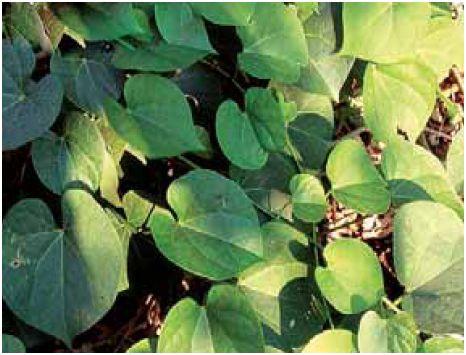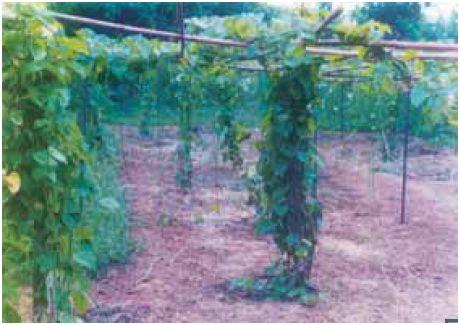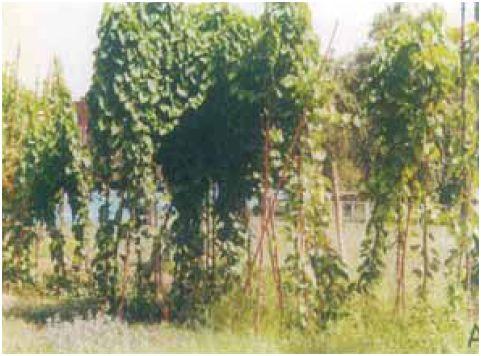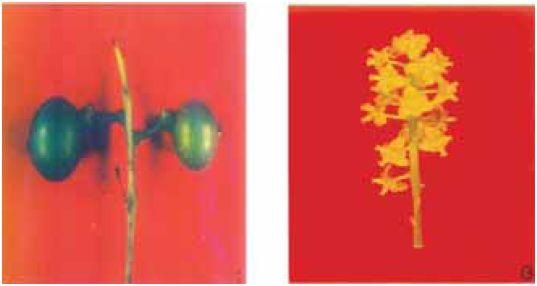Tinospora cordifolia
Tinospora cordifolia
Plant Profile
| Family | Menispermaceae |
| Ayurvedic name | Amrita, Guduchi |
| Unani name | Giloe |
| Hindi name | Giloe, Gurcha |
| Trade name | Giloe |
| Parts used | Stem, root, whole plant |

Tinospora cordifolia - a close view
Therapeutic uses
- Giloe is a tonic and has alterative, diuretic, and aphrodisiac properties.
- It is a febrifuge used in malarial and chronic fever.
- It is also a liver tonic.
- The plant is used in general debility, loss of appetite, fevers, urinary disorders, diabetes, rheumatism, and dyspepsia.
- Fresh plant is more efficacious than dried plant.
Morphological characteristics
- Gurcha is a gregarious glabrous, twiner.
- Older stems are up to 2 cm in diameter and have corky bark.
- Aerial roots arise from nodal scars of branches.
- Stem and branches are specked with white vertical lenticels.
- Bark is grey-brown or creamy white, warty, papery thin, and peels off easily.
- Leaves are 5–15 cm, ovate, and acute.
- They are membranous when young but become more or less leathery with age.
Floral characteristics
- Flowers are yellow, unisexual, minute, and less than 2 mm in size.
- Male flowers are grouped in axillary racemes, while female flowers are solitary.
- Fruit is an ovoid and succulent drupe, lustrous, red in colour, and of the size of a large pea, having a single seed.
- Seed is fleshy and curved. Flowering occurs in May–June, while fruiting is witnessed in September–October.
Distribution
- The species is endemic to India and is common throughout tropical and subtropical zones at an altitude of 600 m.

Tinospora cordifolia - plant
Climate and soil
- The plant grows in subtropical and tropical climate.
- Light medium sandy loam soil rich in organic matter, and with adequate drainage, is suitable for its cultivation.
- It does not tolerate high rainfall or waterlogged conditions.
Propagation material
- Stem cuttings are the best planting material for raising commercial crop.
- The cuttings can be obtained from mother plants in June–July.
- The plant can also be raised using seeds. Seeds take almost more than double the time to mature and yield the same quantity of drug.
Agro-technique
Nursery technique
Raising propagules
- The stem cuttings are sown directly in the field.
- Cuttings are obtained from older stems with nodes.
- Cuttings should be sown within 24 hours of their removal from the mother plant. Meanwhile, they should be half-dipped in water vertically.
Propagule rate and pretreatment
- About 2500 cuttings are required for plantation in 1 hectare of land.
- No specific treatment is required before sowing.

Tinospora cordifolia - crop view
Planting in the field
Land preparation and fertilizer application
- The land is ploughed, harrowed, and made weed-free.
- A basal dose of FYM (farmyard manure) @ 10 tonnes per hectare and half dose of nitrogen (75 kg) are applied at the time of land preparation.
Transplanting and optimum spacing
- The stem cuttings with nodes are sown directly in the field.
- An optimum spacing of 3 m × 3 m is recommended for better yield.
- The plant requires support to grow, which can be provided by raising wooden stakes or trellis.
- Already growing shrubs or trees can also support the plant.
Intercropping system
- Being a large twiner, it needs a host to twine and covers the host in a very short period.
- If the stem cuttings with aerial roots are thrown over trees, they start growing and strike roots in the ground.
Interculture and maintenance practices
- Follow-up dose of 10 tonnes of FYM with 75 kg nitrogen (20% nitrogen content) is recommended.
- About two to three weedings and hoeings are required for good growth of twiner.
- The inter-row spaces between plants should be kept weed-free by frequent weeding and hoeing, as the plants may get suppressed by weeds, especially during early stages of growth.
Irrigation practices
- The crop is grown under rain-fed conditions.
- However, occasional irrigation during extremes of cold and hot weather may help the crop survive adverse conditions.
Disease and pest control
- No serious insect pest infestation or disease has been reported in this crop.

Tinospora cordifolia - fruits and flowers
Harvest management
Crop maturity and harvesting
- The stem is harvested during autumn when it develops to a diameter of more than 2.5 cm. Basal part is left for further growth.
Post-harvest management
- The stem should be cut into small pieces and dried in shade.
- It can be stored in gunny bags, and kept in cool and airy storage godowns.
- Stem bark peels off even by touch, thus stem should be cut very cautiously as peeled stem decays very soon.
Chemical constituents
- The stem contains bitter substances, of which tinosporine, a bitter principle, is a marker compound.
- Other compounds include gilonin, gilosterol, gilenin, and furanoditerpenes.
Yield
- The plant yields about 1500 kg of fresh woody stem, reduced to 300 kg of dry weight per hectare in about two years.
Source :Agro-Techniques of selected medicinal plants
जोबथा दाफामनाय : 7/1/2024
© C–DAC.All content appearing on the vikaspedia portal is through collaborative effort of vikaspedia and its partners.We encourage you to use and share the content in a respectful and fair manner. Please leave all source links intact and adhere to applicable copyright and intellectual property guidelines and laws.
सोमोन्दो गोनां आयदाफोर
Alstonia scholaris
This content provides information about cultivatio...
Alpinia galanga
This content provides information about cultivatio...
Aconitum balfourii
This topic provides information about cultivation ...
Abroma augusta
This content provides information on cultivation o...
